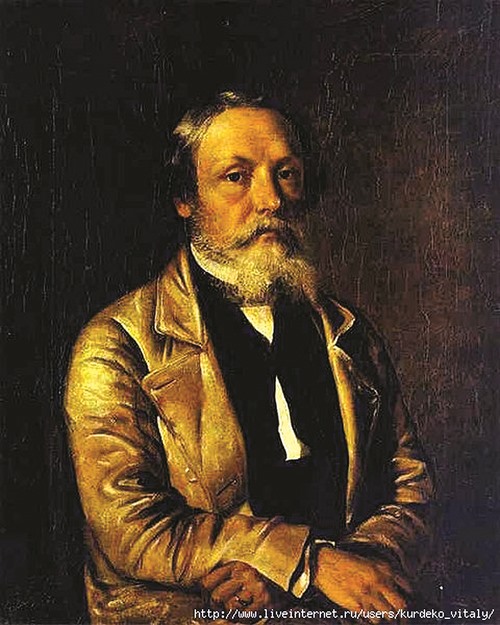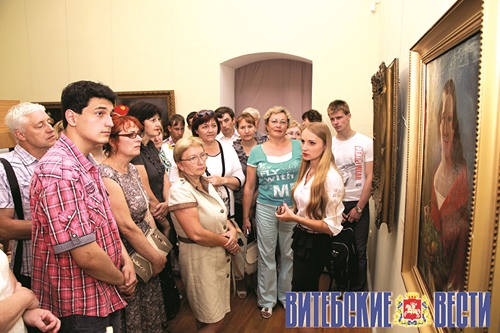The presentation of works by world-famous Ivan Khrutsky was foremost on the agenda at the recent 25th International Slavianski Bazaar in Vitebsk Festival of Arts. Sergey Vecher, Deputy Director General of the National Art Museum, said at the opening that it is symbolic that the exhibition is the first event of the Slavianski Bazaar during this Year of Culture, which is so special for Belarus.

Ivan Khrutsky. A self-portrait . 1884
Ivan Khrutsky was born in 1810 in Ulla, received his artistic education in Polotsk and St. Petersburg, and died at Zakharnichi Estate, in the Polotsk District.
Largest museums of Belarus, Russia, Lithuania, Latvia and Poland are proud to hold Khrutsky’s paintings.
Alexander Sidorenko, Director of the International Slavianski Bazaar in Vitebsk Festival of Arts, indicates the significance of this project, emphasising the importance of sharing our cultural legacy with visitors. He is grateful to Sergey Vecher for fruitful co-operation and feels sure that it will continue.
Ivan Khrutsky is the most famous and yet the least known Belarusian artist. We’re all familiar with his paintings: every Belarusian has held a fragment of one of his still-life works in their hands, as it is depicted on the Br1,000 banknote (not denominated). Yet, few remember the name of the artist. Art historians call Khrutsky the Favourite Stranger, as so much of his life and work remains a mystery.
Belarusians discovered this painter in the post-war years, as legendary Yelena Aladova, in reviving the Art Museum’s collection, set about returning Khrutsky’s paintings to his homeland. He was one of a handful of artists to have been born, lived, died and be buried in Belarus. Within 30 years of the war, Yelena had managed to buy 25 paintings by Khrutsky, from private collectors.
However, it’s easier to buy paintings than to find out the details of their creation. The 19th century, when the artist lived (born in 1810, died in 1885), was an epistolary age, when people often wrote memoirs, yet Khrutsky left no letters, photographs or diaries.
Yet, he was lucky in a different way, since more than a hundred of his pictures have survived to the present day, showing how greatly his work was loved, cared for and preserved.
The eldest son of a priest, it was thought that he would follow his father’s path. At the age of 10, he was sent from his home of Usaya to Polotsk, to study at the lyceum for paupers, where a religious order taught youngsters, providing a brilliant education. Pupils studied mathematics, physics, metaphysics, Latin, rhetoric and verse form.

Presentation of works by painter Ivan Khrutsky in Vitebsk
However, at the age of 17, Ivan dared to go to St. Petersburg to become an artist. Why St. Petersburg, since there was a university in Vilno with an art department? The young man, speaking poor Russian, left for the capital that rarely welcomed anyone. It is unknown whether he had a protector or art patron but we can only imagine the challenges he faced.
Polish researchers interviewed the artist’s grandson, aged 84, shortly before his death, although he was able only to share family anecdotes, rather than definite facts. When in St. Petersburg, it’s thought that Khrutsky took lessons from George Dawe, an outstanding British painter who was invited to the Winter Palace to paint 327 portraits of 1812 war heroes. Why should he give lessons to a youngster from Polotsk? Most likely, Khrutsky was Dawe’s assistant.
He must have had a strong character and far-reaching ambitions. To survive, he had to earn money, and to earn money, he had to make useful liaisons and gain recognition. Ivan Khrutsky found useful acquaintances amidst his fellow countrymen in St. Petersburg. Minsk Province nobleman Yezef Oleshkevich, who was an academician at the Academy of Arts, a mason and a good fellow, helped him obtain a permit to visit the Hermitage, before it became a museum. There, Ivan reproduced the still-life works of Dutch masters, adapting them to suit academic tastes and romantic trends.
Soon, those works were decorating the salons and lounges of the capital, brought back into vogue by Khrutsky. He made six or seven copies of each, since his works were extremely popular, and thus began to earn a living, and recognition. Aged 26, his Flowers and Fruit was awarded a lesser silver medal from the Art Academy, his first award. Two years on, he collected a lesser gold medal. If he could win a great gold medal, as was the dream of all Russian painters of the time, he could claim a six-year apprenticeship in Italy, financed by the state. The Art Academy elaborated a programme for artists, by which they were able to send artworks back to their home country.

Flowers and Fruit by Ivan Khrutsky. 1839
However, these grand plans were doomed to failure, as Ivan’s father, Foma Khrutsky, opposed the unification of the Union and Orthodox churches. One of the initiators of unification was Bishop Iosif Semashko, who later played an important role in Ivan’s life. Priest Foma Khrutsky’s parish was inspected, and he was found guilty, sentenced to be fed only upon bread and water (since priests could not be thrown into jail). Ivan wrote a letter to Metropolitan Iosafat Bulgak, and his father was released. Meanwhile, Ivan — probably, to pay for his father’s release — painted portraits of all the Union Church leaders. In 1839, the Union church was disbanded and Foma Khrutsky lost his parish. He died, leaving Ivan to care for his mother and five younger brothers and sisters. Farewell, Italy!
Aged 29, Ivan won the title of academician at the Art Academy ‘for excellent work in portrait, landscape and especially fruit and vegetable painting’. This title provided him with noble status, both personal and hereditary. In fact, Khrutsky became twice a nobleman, as at around the same time, the Russian Empire required Polish nobles to confirm their status after the 1830 rebellion, and he did so.
Khrutsky worked hard, painting 21 portraits over three years: one every 2-3 months, in ‘workaholic’ style. He mainly painted high-ranking people, such as the heads of the St. Petersburg municipality, as he badly needed income.
In 1844, aged 34, he bought land in Polotsk’s suburbs, as was the right only of Orthodox Russian-speaking nobles. Khrutsky built a self-designed house on the shore of the lake, and planted a garden, which was considered a luxury. He continued to make useful connections by painting portraits of the main noblemen of Vitebsk and Polotsk provinces and of the Lepel District.
After a year, he married his neighbour, Anna-Katarina Bembnovskaya, but left town shortly afterwards. Bishop Semashko invited him to Vilno to decorate an eparch house and paint portraits of clergymen. Some researchers consider that Khrutsky lived in involuntary servitude but he was lucky to find a patron ready to provide him with orders, accommodation and money. He spent ten years commuting between two houses, which may be why he only had two children. Before his death, Semashko permitted Khrutsky his ‘freedom’ and the painter returned to Zakharnichi, to live as a real landowner, managing his estate.
He continued to paint portraits of his children and his favourite fruit, mushrooms and vegetables but few of these artworks are known today. He spent the last twenty years of his life in oblivion. Perhaps, he didn’t know that Tretyakov bought one of his still-life works at an auction in Moscow. However, being bought by the Tretyakov Gallery meant unarguable recognition.
Before his death, Khrutsky created two self-portraits, for his son and daughter. This is the only image of the artist to have survived into the present day. Strangely, upon his death, in 1885, the Art Academy academician received no obituary, in Polotsk, Vitebsk or St. Petersburg. He had fallen into oblivion.
The painter’s descendants lived in Zakharnichi until the 1920s, when the estate was nationalised, the house burnt down and the cemetery removed. Ivan Khrutsky’s grave disappeared but a monument now stands on the site indicated by his grand-granddaughter’s recollections.
Khrutsky painted many lovely portraits of women, although their identities remain unclear. Many art historians wonder why he never painted his wife, since he portrayed all his relatives. Long before he married, he would portray a woman we know from the painting An Unknown Woman with Flowers and Fruit. She features in his pictures as a little girl, as an adult, as pregnant, and as having aged. His descendants muse that she was his wife, whom he knew as an 8-year old and whom he married after having built the estate. Others suggest that she is his younger sister, and that all the women in his pictures depicted as ‘beautiful gardeners’ are his sisters. All are very much alike.
By Veniamin Mikheev











